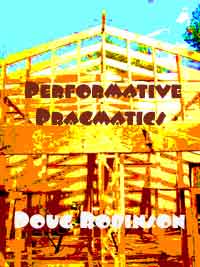
 |
Teacher's Guide
General
The Structure of the Book
The large-scale
structure of the book, based on the four parts, should be pretty obvious: introduction,
speech acts, implicatures, the body. As the historical chapter in the introduction
makes clear, speech acts (1955/1962) were the first great "moment" in
linguistic pragmatics and implicatures (1967/1975) were the second. The body is
still a marginal and fairly controversial part of pragmatics, and really only
comes to the fore in a specifically performative pragmatics, so it is right that
it should come last.
But
I've built some more covert structures into the book's argument as well. One is
that, as you might expect, things move from the obvious and conventional to the
surprising and new. This is the reason for putting the material on the body last,
of course. But that same argumentative movement is at play in each part as well,
and in each chapter.
For
example, the core of linguistic pragmatics is Austin on speech acts and Grice
on implicatures; and I present the former in the beginning of Part II and the
latter in the beginning of Part III. But:
Part
II starts with Austin on performatives and then, before even moving with Austin
to his expanded speech-act framework (locutions, illocutions, perlocutions), progressively
expands performativity through the study of magic to the study of identity to
Judith Butler's radically performative conception of gay and lesbian identities.
The old to the new; the conventional to the radical. This radically reframed conception
of performativity is, of course, the methodological groundwork for the book's
entire approach to the study of language, as well.
The
second chapter of Part II, Chapter 4 on types of speech act, moves similarly from
the straight-forward attempts of Austin and his followers to fit all speech acts
into five categories, through Ballmer and Brennestuhl's out-of-control celebration
of six hundred speech act types, to the suggestion that the important thing here
is not locking into a rigid taxonomy but rather the heuristic process of inventing
speech-act taxonomies.
And
Chapter 5 offers the first truly performative revision of traditional pragmatics,
the insight from Erving Goffman and his sociological followers (especially John
Gumperz and Harold Garfinkel) that individuals don't merely "recognize"
context; groups construct context. Thus "context-creation" becomes a
by-product of speech acts; we create context through speech acts. Chapter 6 follows
up on this performative transformation of context studies by using Harold Garfinkel's
ethnomethodology to reframe the study of turn-taking in terms of conversational
structuring acts—CSAs being again, like context-creating acts, themselves
speech acts.
Part III, too,
begins with Grice's theory of implicature, more or less "straight":
the theory of implicature (flouting maxims) in Chapter 7, the part of Grice's
theory that pragmaticians all talk about at length; and the theory of violating
and infringing maxims (which Grice barely mentions, and his followers don't seem
to be particularly interested in either) in Chapter 8.
Chapter
9, then, deals with the breakdown of Grice's model, and a series of radical performative
expansions of his ideas: the maxims as cultural differences; the maxims as caught
up in the movement of time (the conventionalization of conversational implicature
as an engine of language change); the maxims as personal difference; and, most
radically of all, drawing on Norman Fairclough's work, the maxims and power.
And Chapter 10 offers a radically
unGricean alternative to the maxim-flouting structure of implicature: we can implicate
things by invoking old and familiar words and phrases in new contexts, in new
ways, by putting a new verbal (allusion) or tonal (double-voicing) twist on them.
A performative approach to pragmatics
brings lots of methodological changes. Two of the most important are the importance
of the group and the importance of the body. I build up to these two methodological
shifts gradually as well. Rather than stressing the importance of the group from
the start, for example, I begin with the classic pragmatic emphasis on individuals
performing speech acts (Part II) and implicating things (Part III), and gradually,
over the course of each part, add collective elements until by Chapter 5 on context
and Chapter 6 on turn-taking, and by the end of Chapter 9 on divergent maxims
(the concluding section on power), verbal actions are group actions. And I build
up to a haptic/somatic (bodily) conception of verbal action slowly over both Part
II and Part III, finally broaching it openly in the final section of Part III's
final chapter, the section on Bakhtin's double-voicing—the segue into Part
IV on the body.
This does not mean, of course, that I think embodied group actions are irrelevant to the earlier discussions; only that I am trying to take students through a methodological transition from the earlier individualist/mentalist mode of pragmatic study to the more recent collectivist/physicalist mode. You are encouraged to do whatever you can to help students see the collective and somatic nature of conversation in every "early" discussion as well—every discussion where things seem pretty conventionally individualistic and mentalist.
More: Teacher's Guide index
